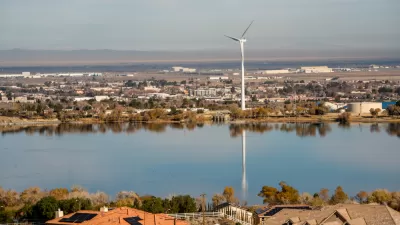This past Friday, demolition began on a segment of Baltimore's infamous "Highway to Nowhere" to expand parking for the local commuter rail service (MARC). A side benefit: reuniting communities separated since the 1970s.
In a press release, Governor Martin O'Malley (who was also at the groundbreaking), said:
"The communities of West Baltimore have been frustrated and divided by this concrete wall for nearly four decades," said Governor O'Malley. "It is time to remove the unnecessary divider, reunite communities and make neighborhood-friendly improvements to the MARC station while creating jobs. With the Red Line and our transit oriented development vision for the area moving forward, the future of West Baltimore holds great promise."
The Governor's press release notes that in the original construction of the freeway, "Nearly 700 homes were taken, displacing working-class families, by the time construction of what was known as I-170 got underway in 1974. Public opposition by civil rights leaders, community activists and others to a network of urban highways that were planned to cut through the city eventually stopped construction of I-170 but not before a 1.4 mile section was completed through West Baltimore."
Thanks to John Coleman
FULL STORY: Governor O'Malley Breaks Ground on Removal of West Baltimore's 'Highway to Nowhere'

Planetizen Federal Action Tracker
A weekly monitor of how Trump’s orders and actions are impacting planners and planning in America.

Maui's Vacation Rental Debate Turns Ugly
Verbal attacks, misinformation campaigns and fistfights plague a high-stakes debate to convert thousands of vacation rentals into long-term housing.

Restaurant Patios Were a Pandemic Win — Why Were They so Hard to Keep?
Social distancing requirements and changes in travel patterns prompted cities to pilot new uses for street and sidewalk space. Then it got complicated.

In California Battle of Housing vs. Environment, Housing Just Won
A new state law significantly limits the power of CEQA, an environmental review law that served as a powerful tool for blocking new development.

Boulder Eliminates Parking Minimums Citywide
Officials estimate the cost of building a single underground parking space at up to $100,000.

Orange County, Florida Adopts Largest US “Sprawl Repair” Code
The ‘Orange Code’ seeks to rectify decades of sprawl-inducing, car-oriented development.
Urban Design for Planners 1: Software Tools
This six-course series explores essential urban design concepts using open source software and equips planners with the tools they need to participate fully in the urban design process.
Planning for Universal Design
Learn the tools for implementing Universal Design in planning regulations.
Heyer Gruel & Associates PA
JM Goldson LLC
Custer County Colorado
City of Camden Redevelopment Agency
City of Astoria
Transportation Research & Education Center (TREC) at Portland State University
Jefferson Parish Government
Camden Redevelopment Agency
City of Claremont





























